Noise Complaints between Japanese Neighbors and Migrants in Rural Japan: From the Perspectives of Noisemakers
Abstract
1. Introduction
2. Background
2.1. Noise
2.2. Sound-to-Noisemaking and Noise Complaint
2.3. Noise Complaints and Neighbor–Migrant Relations in Japan
2.4. Migration in Rural Oarai
3. Research Methods and Settings
3.1. Participants and Settings
3.2. Methods
4. Findings
4.1. Priscilla and Barbed Wire
“Japanese people don’t like if we are noisy. Well, it is the same thing as people in our kampung13. [They] also don’t like if we are noisy, right? Japanese people after 9 p.m. want to go to sleep. That is their sleeping time, resting time.” (in a very calm tone).
“How ‘noisy’?” I asked. Still with the same calm tone, Priscilla continued:
“There are some … people who talk too loudly. Some neighbors might get used to these, but some others have not. They cannot. Just like neighbors in front of that door.” She indicated the doorway on my opposite.
“In the past, when I just climbed the stairs, the oma14 (the neighbor) knocked the walls.” Priscilla knocked the table to illustrate.
““Aa, noisy!” She (the neighbor) shouted.” Priscilla illustrated it in a whisper.
She lowered her tone and sounded a little apprehensive. “Then, I wondered, what should I do; I only want to walk in the house? I cannot walk or climb the stairs … it always makes a sound. What should I do?”
“One day, the oma was angry. She wanted to call the policeman. “I want to call the policeman”, she said. Then I said, “Yes, it’s fine if you want to call the policeman, we don’t make any keributan15. We only talked in the house. We don’t make any keributan.” Then she went back to her house …”
“So, did she call the policeman?” I asked.
“No, maybe (at first) she thought we were migrants without staying permission.”
4.2. Bella and X-Chan
“But the only mondai (problem) is that person, X-chan. He didn’t behave that way before. We don’t know what happened to him. Was there someone hating us that told X-chan16 something, so he changed his behavior? He just suddenly changed. Suddenly, he was so angry. When we just talked like this, he hit that wall. … In the past, he was fine. We even held a liturgy at home every Saturday, Tuesday, Friday. There was no problem when he had just moved in. […] Before him, it was a Peruvian family living there. They also had no problem.”
“We said to him: “You are the one who gets noisy. You are noisy with your cat. […] You knocked the walls. You often do this (knocked the table). Later we will record it. We will report you to the policeman.” […] It is because he easily reports to shachou … We challenged him, “You report to shachou, we will report to policemen.” (Then) He said, “Douzo-douzo (go ahead), report to the policemen. I am sure you yourself are afraid because you are just gaijin (foreigner).” We said, “No, we are not afraid. You want us to report you now? You want us to call the policemen now? Want now?” He was silent.”
4.3. My Interactions in the Neighborhood
4.4. Dena: Dirt and Pebble-Throwing
4.5. Karinda and the Cucumber
4.6. Leo and Neighbors’ Rejection
“If here, with the people is not good, it is difficult.”
“Neighbors?” I asked. He did not answer and just continued his story.
“It has been 10 years. If they are not willing to [accept] us, if they hate foreigners, they will hate them until … (trails off) … that kind of characters exist. If they are, from the first time hate foreigners, it is impossible to change it, even if we give them anything, they will not like us. Some people are open, but some people are difficult. Even though we don’t disturb them, they won’t change it. From the past, this place (the apaato) has been the place of foreigners. So, they can’t accept it.”
He continued with low tones. I continued to feel his painful rejection. “What’s the example?” I asked.
“Well … (sighs) If we usually say good morning or anything else… they just ignored it. But that was only a standard of people run across, right? Aisatsu (greetings). But, because from the first time … (he pauses) There was one occasion, at that time, I was walking, and he suddenly drove back his car carelessly, with an intention to hit me! It means … it seems [they] don’t like us. [As] it has been from the first impression, not good, [it will not be good] forever and ever. If they could accept us, we should have been close. […] If he doesn’t care, perpetually, he won’t care to us. That is [how] Japanese [are]. If they care, wherever we are… ‘ah, we’ve met.’ [showing intimacy] like that.”
5. Discussion
5.1. ‘Noise’: the Unwanted Body
5.2. Noise Conflicts: Social Power Over Space
6. Conclusions
Funding
Acknowledgments
Conflicts of Interest
References
- Alesina, Alberto, and Eliana La Ferrara. 2002. Who Trusts Others? Journal of Public Economics 85: 207–34. [Google Scholar] [CrossRef]
- Aletta, Francesco, Timothy van Renterghem, and Dick Botteldooren. 2018. Influence of Personal Factors on Sound Perception and Overall Experience in Urban Green Areas. A Case Study of a Cycling Path Highly Exposed to Road Traffic Noise. International Journal of Environmental Research and Public Health 15: 1118. [Google Scholar] [CrossRef] [PubMed]
- Appleyard, Donald, and Mark Lintell. 1971. Environmental quality of city streets: the residents’ viewpoint. Journal of the American Institute of Planners 38: 84–101. [Google Scholar] [CrossRef]
- Augoyard, Jean-François, and Henri Torgue. 2005. Sonic Experience. A Guide to Everyday Sounds. Edited and Translated by Andra McCartney and David Paquette. Montreal and Kingston: McGill-Queen’s University Press. [Google Scholar]
- Bourdieu, Pierre. 1993. Effets de lieux [Site effects]. In La misère du monde. Edited by Pierre Bourdieu. Seuil and Paris: Polity Press, English Translation. 1999. As The Weight of the World. Cambridge: Polity. [Google Scholar]
- Broadbent, Donald Eric, and E. A. J. Little. 1960. Effects of noise reduction in a work situation. Occupational Psychology 34: 133–40. [Google Scholar]
- Bronzaft, Arline, and Gregg van Ryzin. 2004. Neighborhood Noise and its Consequences. Special Report #3. New York: School of Public Affairs, Baruch College/CUNY. New York: eTownPanel.com. [Google Scholar]
- Chen, Xinguang, Bonita Stanton, Linda Kaljee, Xiaoyi Fang, Qing Xiong, Danhua Lin, Liying Zhang, and Xiaoming Chen. 2011. Social stigma, social capital reconstruction, and rural migrants in urban China: A population health perspective. Human Organization 70: 22–32. [Google Scholar] [CrossRef] [PubMed]
- Danson, Mike, and Birgit Jentch. 2012. International migration and economic participation in small towns and rural areas–cross-national evidence. Migration Letters 9: 215–24. [Google Scholar] [CrossRef]
- De Carvalho, Daniela. 2003. Nikkei communities in Japan. In Global Japan: The Experience of Japan’s New Immigrant and Overseas Communities. Edited by Roger Goodman, Ceri Peach, Ayumi Takenaka and Paul White. London: RoutledgeCurzon, pp. 195–208. [Google Scholar]
- De Lima, Philomena. 2012. Boundary Crossings: Migration, Belonging/‘Un-belonging’ in Rural Scotland. In Translocal Ruralism: Mobility and Connectivity in European Rural Spaces. GeoJurnal Library. Edited by Charlotta Hedberg and Renato Miguel do Carmo. Dordrecht: Springer, vol. 103, pp. 203–17. [Google Scholar]
- De Lima, Philomena, and Sharon Wright. 2009. Welcoming migrants? Migrant labour in rural Scotland. Social Policy and Society 8: 391–404. [Google Scholar] [CrossRef]
- Deleuze, Gilles, and Félix Guattari. 1991. Qu’est-ce que la philosophie? Paris: Les Editions de Minuit. Translated by Graham Burchell, and Hugh Tomlinson. 1994. As What Is Philosophy? New York: Columbio University Press. [Google Scholar]
- Dolan, Daniel. 2008. Cultural Noise: Amplified Sound, Freedom of Expression and Privacy Rights in Japan. International Journal of Communication 2: 662–90. [Google Scholar]
- Gendlin, Eugene T. 1992. The Wider Role of Bodily Snese in Thought and Language. In Giving the Body Its Due. Edited by Maxine Sheets-Johnstone. Albany: SUNY Press, pp. 192–207. [Google Scholar]
- Gloag, Daphne. 1980. Noise and health: Public and private responsibility. British Medical Journal 281: 1404–6. [Google Scholar] [CrossRef]
- Goffman, Ervin. 1963. Stigma. Englewood Cliffs: Prentice-Hall. [Google Scholar]
- Goffman, Ervin. 2001. On fieldwork. In Contemporary Field Research. Edited by Robert M. Emerson. Prospect Heights: Waveland Press, vol. 24, pp. 623–50. [Google Scholar]
- Gurney, Craig. 2000. Transgressing Private-Public Boundaries in the Home: A Sociological Analysis of the Coital Noise Taboo. Venereology 13: 39–46. [Google Scholar]
- Hainge, Greg. 2013. Noise Matters: Towards an Ontology of Noise. New York: Bloomsbury Academic. [Google Scholar]
- Hankins, Joseph D. 2014. Publics that scream, publics that slumber. In Sound, Space and Sociality in Modern Japan. Edited by Joseph D. Hankins and Carolyn S. Stevens. London and New York: Routledge. [Google Scholar]
- Hiramatsu, Kozo. 1993. Some aspects of soundscape studies in Japan. Journal of the Acoustical Society of Japan 14: 133–38. [Google Scholar] [CrossRef][Green Version]
- Honda, Hideomi, and Seiichiro Ono. 2000. Aji Himono Gohatsu Sanchi Oarai no Taito. Chiiki Gyogyo Kenkyu 40: 141–53. [Google Scholar]
- Janssen, Sabine A., and Henk Vos. 2011. A comparison between exposure-response relationships for wind turbine annoyance and annoyance due to other noise sources. The Journal of the Acoustical Society of America 130: 3746–53. [Google Scholar] [CrossRef] [PubMed]
- Johnson, Kristen Linnea, and Michael Elwood Roloff. 2000. Correlates of the Perceived Resolvability and Relational Consequences of Serial Arguing in Dating Relationships: Argumentative Features and the Use of Coping Strategies. Journal of Social and Personal Relationships 17: 677–78. [Google Scholar] [CrossRef]
- Jones, Richard G., Jr. 2013. Communication in the Real World: An Introduction to Communication Studies. Irvington: Flat World Knowledge. [Google Scholar]
- Jones, Dylan M., Antony J. Chapman, and Timothy C. Auburn. 1981. Noise in the Environment: A Social Perspective. Journal of Environmental Psychology 1: 43–59. [Google Scholar] [CrossRef]
- Keizer, Garret. 2010. The Unwanted Sound of Everything We Want: A Book About Noise. New York: Public Affairs. [Google Scholar]
- Krieger, Daniel. 2014. Making noise about keeping the decibels down. The Japan Times. October 10. Available online: https://www.japantimes.co.jp/life/2014/10/10/lifestyle/making-noise-keeping-decibels/#.W8GvZLaB1mA (accessed on 1 October 2018).
- Levy-Leboyer, Claude, and Veronique Naturel. 1991. Neighborhood Noise Annoyance. Journal of Environmental Psychology 11: 75–86. [Google Scholar] [CrossRef]
- Lindsay, Morag, Katie Williams, and Carol Dair. 2010. Is There Room for Privacy in the Compact City? Built Environment 36: 28–46. [Google Scholar] [CrossRef]
- Linger, Daniel Touro. 2001. No One Home: Brazilian Selves Remade in Japan. Stanford: Stanford University Press. [Google Scholar]
- Mazumi, Yusuke. 2014. How Does Labor Migration Occur in Japan?: Policy and Labor Demand in the Seafood Processing Industry. Ph.D. dissertation, University of California, San Diego, CA, USA. [Google Scholar]
- McKennell, Aubrey. 1963. Aircraft Noise Annoyance around Heathrow Airport. London: Her Majesty’s Stationary Office. [Google Scholar]
- Mee, Katleen. 2007. “I Ain’t Been to Heaven Yet? Living Here, This is Heaven to Me”: Public Housing and the Making of Home in Inner Newcastle. Housing, Theory and Society 24: 207–28. [Google Scholar] [CrossRef]
- Meguro, Ushio. 2005. Establishment of the Japanese-Indonesian Community and their Employment System in the Oarai Town, Ibaraki. I bunka komyunikēshon kenkyū 17. [Google Scholar]
- Meguro, Ushio. 2010. Social Capital and Job-Searching Processes of Japanese-Minahasans in Oarai, Ibaraki Prefecture, Japan. Geographical Review of Japan Series B (The Association of Japanese Geographers) 82: 167–83. [Google Scholar]
- Mutiara, Median. 2018. Managing Boundaries between (Dirty) Work and Church Life for Indonesian Migrant Workers in Japan. IAFOR Journal of Cultural Studies 3: 43–63. [Google Scholar] [CrossRef]
- Nancy, Jean-Luc. 1992. Corpus. Paris: Editions Métailié. [Google Scholar]
- Nancy, Jean-Luc. 2000. Being Singular Plural. Stanford: Stanford University Press. [Google Scholar]
- Nash, Lindsay. 2009. Mending Wall: Playing the Game of Neighborhood Ordering. Yale Journal of Law & the Humanities (Yale Law School Legal Scholarship Repository) 21: 173–201. [Google Scholar]
- Niemann, Hildegard, Xavier Bonnefoy, Matthias Braubach, Karl Hecht, Christian Maschke, C. Rodrigues, and Nathalie Robbel. 2006. Noise-induced annoyance and morbidity results from the pan- European LARES study. Noise & Health 8: 63–79. [Google Scholar]
- Oku Okokon, Enembe, Anu W. Turunen, S Ung-Lanki, Anna-Kaisa Vartiainen, Pekka Tiittanen, Timo Lanki, Peter Lercher, Ronny Klaeboe, and Mariola Śliwińska-Kowalska. 2015. Road-Traffic Noise: Annoyance, Risk Perception, and Noise Sensitivity in the Finnish Adult Population. International Journal of Environment Research and Public Health 12: 5712–34. [Google Scholar] [CrossRef]
- Park, Sang Hee, and Pyoung Jik Lee. 2017. Effects of floor impact noise on people—Annoyance and physiological responses. Paper presented at 12th ICBEN Congress on Noise as a Public Health Problem, Zurich, Switzerland, June 18–22. [Google Scholar]
- Petersen, Sandra Lori. 2016. Noise, Social Housing and Sleep: A Social Science Review. København: University of Copenhagen. [Google Scholar]
- Pinçon-charlot, Monique, and Michel Pinçon. 2018. Social Power and Power Over Space: How the Bourgeoisie Reproduces Itself in the City. International Journal of Urban and Regional Research 42: 115–25. [Google Scholar] [CrossRef]
- Plourde, Lorraine. 2014. Distraction, noise, and ambient sounds in Tokyo. In Sound, Space and Sociality in Modern Japan. Edited by Joseph D. Hankins and Carolyn S. Stevens. London and New York: Routledge, pp. 71–88. [Google Scholar]
- Pudjiastuti, Tri Nuke. 2005. The Dynamics of Indonesian Migrant Workers under National and Local Policies: The Oarai Case. I bunka komyunikēshon kenkyū 17: 79–104. [Google Scholar]
- Pugh, Richard. 2007. New Migrants and Minorities: Understanding Difference and Discrimination in Rural Areas. Paper distributed at the Conference ‘International Migration and Rural Areas: Global Perspectives, Isle of Skye, Scotland, UK, 11–12 October. [Google Scholar]
- Ricke, Audrey. 2017. Making “Sense” of Identity: Ethnicity, Nationalism, and the Sensory Experience of German Traditions in Brazil. Journal of Contemporary Ethnography 46: 173–202. [Google Scholar] [CrossRef]
- Rivera, Kendra Dyanne, and Sarah J. Tracy. 2014. Embodying emotional dirty work: A messy text of patrolling the border. Qualitative Research in Organizations and Management: An International Journal 9: 201–22. [Google Scholar] [CrossRef]
- Roberts, Kenneth D. 2002. Rural migrants in urban China: Willing workers, invisible residents. Asia Pacific Business Review 8: 141–58. [Google Scholar] [CrossRef]
- Rothwell, Dan J. 2004. In the Company of Others: An Introduction to Communication. New York: McGraw Hill. [Google Scholar]
- Schulze, Holger. 2012. The body of sound: Sounding out the history of science. Sound Effects 2: 198–209. [Google Scholar]
- Schulze, Holger. 2018. The Sonic Persona: An Anthropology of Sound. New York and London: Bloomsbury. [Google Scholar]
- Serres, Michel. 1985. Philosophie des corps meles: Les Cinq Sens. Paris: Editions Gallimard. [Google Scholar]
- Shin, Hwaji. 2010. Colonial legacy of ethno-racial inequality in Japan. Theory and Society 39: 327–42. [Google Scholar] [CrossRef]
- Skara, Danica. 2004. Body Metaphors—Reading the Body in Contemporary Culture. Collegium Antropologicum 28 S1: 183–89. [Google Scholar]
- Smith, Andrew P. 2003. The Concept of Noise Sensitivity: Implications for Noise Control. Noise & Health 5: 57–59. [Google Scholar]
- Stokoe, Elizabeth. 2003. Mothers, Single Women and Sluts: Gender, Morality and Membership Categorization in Neighbour Disputes. Feminism and Psychology 13: 317–44. [Google Scholar] [CrossRef]
- Stokoe, Elizabeth. 2006. Public Intimacy in Neighbour Relationships and Complaints. Sociological Research Online 11: 2–20. [Google Scholar] [CrossRef]
- Stokoe, Elizabeth, and Alexa Hepburn. 2005. ‘You can hear a lot through the walls’: Noise formulations in neighbour complaints. Discourse & Society 16: 647–73. [Google Scholar]
- Stokoe, Elizabeth H., and Jodi Wallwork. 2003. Space Invaders: The moral-spatial order in neighbour dispute discourse. British Journal of Social Psychology 42: 551–69. [Google Scholar] [CrossRef]
- Sugino, Toshiko. 2008. Nikkei Brazilians at a Brazilian School in Japan. Tokyo: Keio University Press. [Google Scholar]
- Sumakul, Henny WIlliam Booth. 2005. The Concept of Vocation Amongst Migrant Workers of the GMIM (Christian Evangelical Church in Minahasa) in Postmodern Times. Ph.D. dissertation, Faculty of Theology, University of the Free State, Bloemfontein, South Africa. [Google Scholar]
- Sunderland, Naomi, Helen Bristed, Ori Gudes, Jennifer Boddy, and M. Da Silva. 2012. What does it feel like to live here? Exploring sensory ethnography as a collaborative methodology for investigating social determinants of health in place. Health & Place 18: 1056–67. [Google Scholar]
- Tarnopolsky, Alex, S. M. Barker, R. D. Wiggins, and E. K. McLean. 1978. The effect of aircraft noise on the mental health of a community sample: A pilot study. Psychological Medicine 8: 219–33. [Google Scholar] [CrossRef]
- Tirtosudarmo, Riwanto. 2005. The Making of a Minahasan Community in Oarai: Preliminary Research on Social Institutions of Indonesian Migrant Workers in Japan. I bunka komyunikēshon kenkyū 17: 105–38. [Google Scholar]
- Tsuda, Takeyuki. 1999. The Permanence of “Temporary” Migration: The “Structural Embeddedness” of Japanese Brazilian Immigrant Workers in Japan. The Journal of Asian Studies (Association for Asian Studies). 58: 687–722. [Google Scholar] [CrossRef]
- Tsuda, Takeyuki. 2000. Migration and Alienation: Japanese-Brazilian Return Migrants and the Search for Homeland Abroad. Available online: http://www.bristol.ac.uk/ (accessed on 25 May 2018).
- Tsuda, Takeyuki. 2003. Stranger in the Ethnic Homeland: Japanese Brazilian Return Migration in Transnational Perspective. New York: Columbia University Press. [Google Scholar]
- United Nations Department of Economic and Social Affairs. 2018. Prejudice and Discrimination: Barriers to Social Inclusion. Social Development Brief #4. New York: Division for Social Policy and Development, UNDESA, United Nations Department of Economic and Social Affairs. [Google Scholar]
- Van Gunsteren, Herman R. 1999. When noise becomes too much noise. Noise & Health 3: 3–5. [Google Scholar]
- Van Kamp, Irene, Raymond Soames Job, Julie Hatfield, Mary Haines, Rebecca K Stellato, and Stephen A Stansfeld. 2004. The role of noise sensitivity in the noise-response relation: A comparison of three international airport studies. The Journal of the Acoustical Society of America 116: 3471–79. [Google Scholar] [CrossRef] [PubMed]
- Weinhold, Diana. 2015. Sick of Noise: The Health Effects of Loud Neighbours and Urban Din. Working Paper No. 213. Grantham Research Institute on Climate Change and the Environment. Available online: http://www.lse.ac.uk/GranthamInstitute/publication/sick-of-noise-the-health-effects-of-loud-neighbours-and-urban-din/ (accessed on 26 June 2018).
| 1 | When noise hearers decide to make a complaint, their attribution is listed as a complaint-maker. At the same time, if the noisemakers receive a complaint, their attribution becomes a complaint-receiver. I will use these terms to refer to the events and the actors or to emphasize which event is currently being discussed. |
| 2 | Mito is the capital of Ibaraki Prefecture, which is located approximately 11 km from Oarai. The pastors of this church in Mito often assist the congregation of an Indonesian church in Oarai with ecclesiastical matters. |
| 3 | In Sumakul’s study, he uses the term ‘Minahasan’ to address the ethnicity of Indonesian migrants from North Sulawesi in Oarai. |
| 4 | The church is an ethnic church with all Indonesian members and pastors. |
| 5 | Nikkeijin in general refers to Japanese descendants who live outside Japan. |
| 6 | |
| 7 | Besides the abovementioned prefectures, there is another concentration of Japanese Brazilian in a small town, Oizumi, Gunma prefecture (see De Carvalho 2003), which is similar to the case of Oarai. |
| 8 | |
| 9 | As of April 2005, Indonesians were the largest group of foreigners, with 443 people, followed by Chinese (154), Filipinos (112), Thais (58), and Brazilians (25), according to Oarai’s foreigner registration documents (Meguro 2005). |
| 10 | Most participants pronounced it as “aparto”. |
| 11 | Bahasa Manado is the North Sulawesi people’s colloquial language (Manado itself is the name of capital of North Sulawesi). The language diction is absorbed from Malay, Dutch, Japanese, and Spanish as a result of the colonial history in Celebes (the previous name of Sulawesi). |
| 12 | I learned the process of how migrants started acquiring Japanese language from newcomer refugees in Oarai who asked me to teach them Japanese. |
| 13 | A kampung (Bahasa Indonesian) is a group of houses which are part of the city (usually inhabited by low-income people); village; hamlet; the smallest administrative unit occupying a certain area, located under the subdistrict level; a backward (not modern) place; related to habits in the village; old-fashioned; page of the area or village of birth (based on Kamus Besar Bahasa Indonesian online). |
| 14 | Oma (Bahasa Indonesian/Bahasa Manado) is grandmother. |
| 15 | Keributan (Bahasa Indonesian) is disturbance. |
| 16 | In Japanese, -chan is usually used to address children or a younger person. The Japanese man is called with -chan by the shachou, and this is how Bella addressed him too. |
| 17 | The previous tenants were an Indonesian family working in the kaisha, who lived there for seven years. They were overstaying migrants and were deported because their visa proposal was rejected in court. |
| 18 | The apaato is about 25 m2, with a kitchen, toilet, bathroom, washroom, and two bedrooms. |
| 19 | Opa (Bahasa Indonesian/Bahasa Manado) means grandfather. |
| 20 | |
| 21 | Because of some limitations, this study could not attempt to seek the perspective of the Japanese neighbors. This would be recommended for future research. |
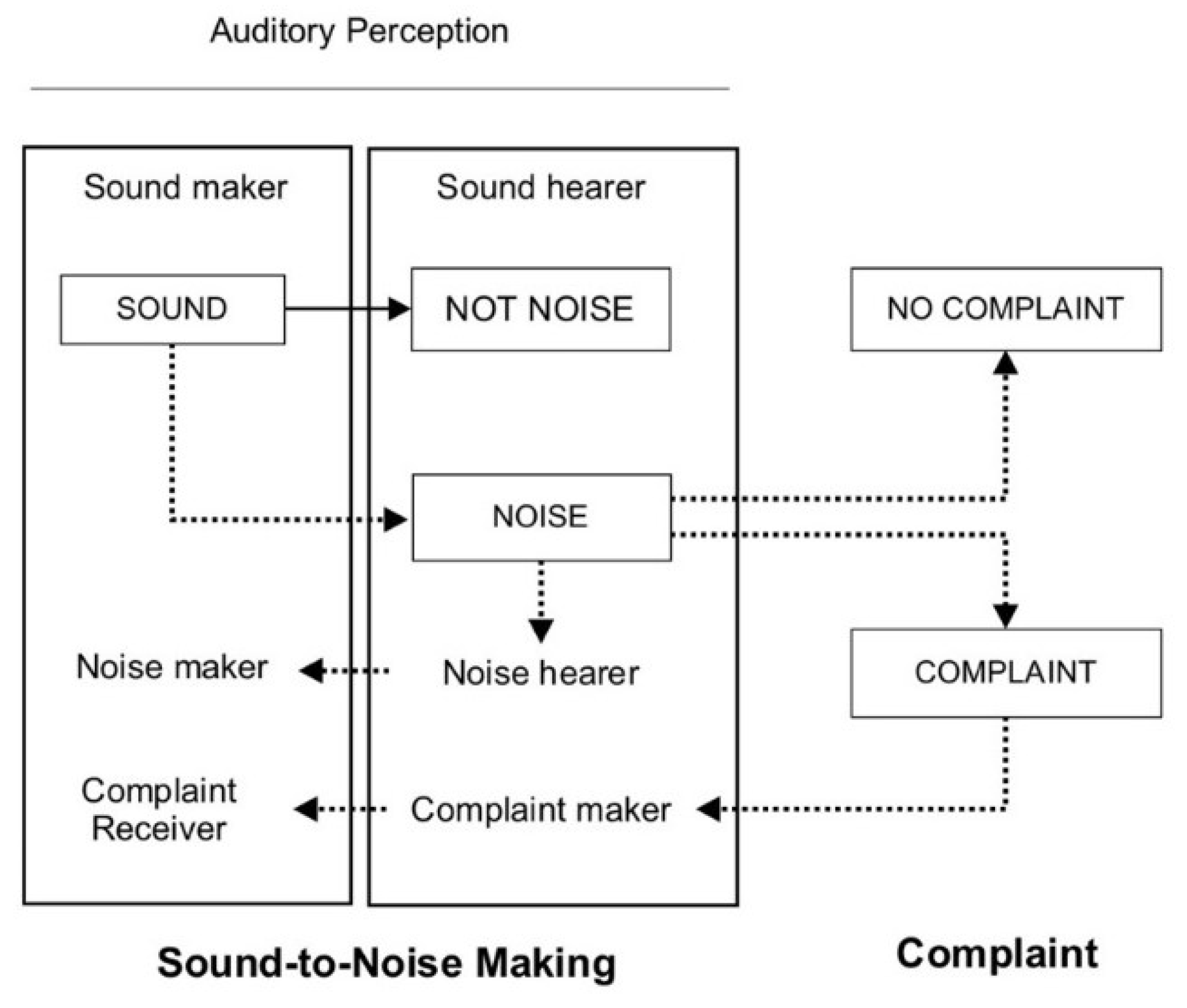
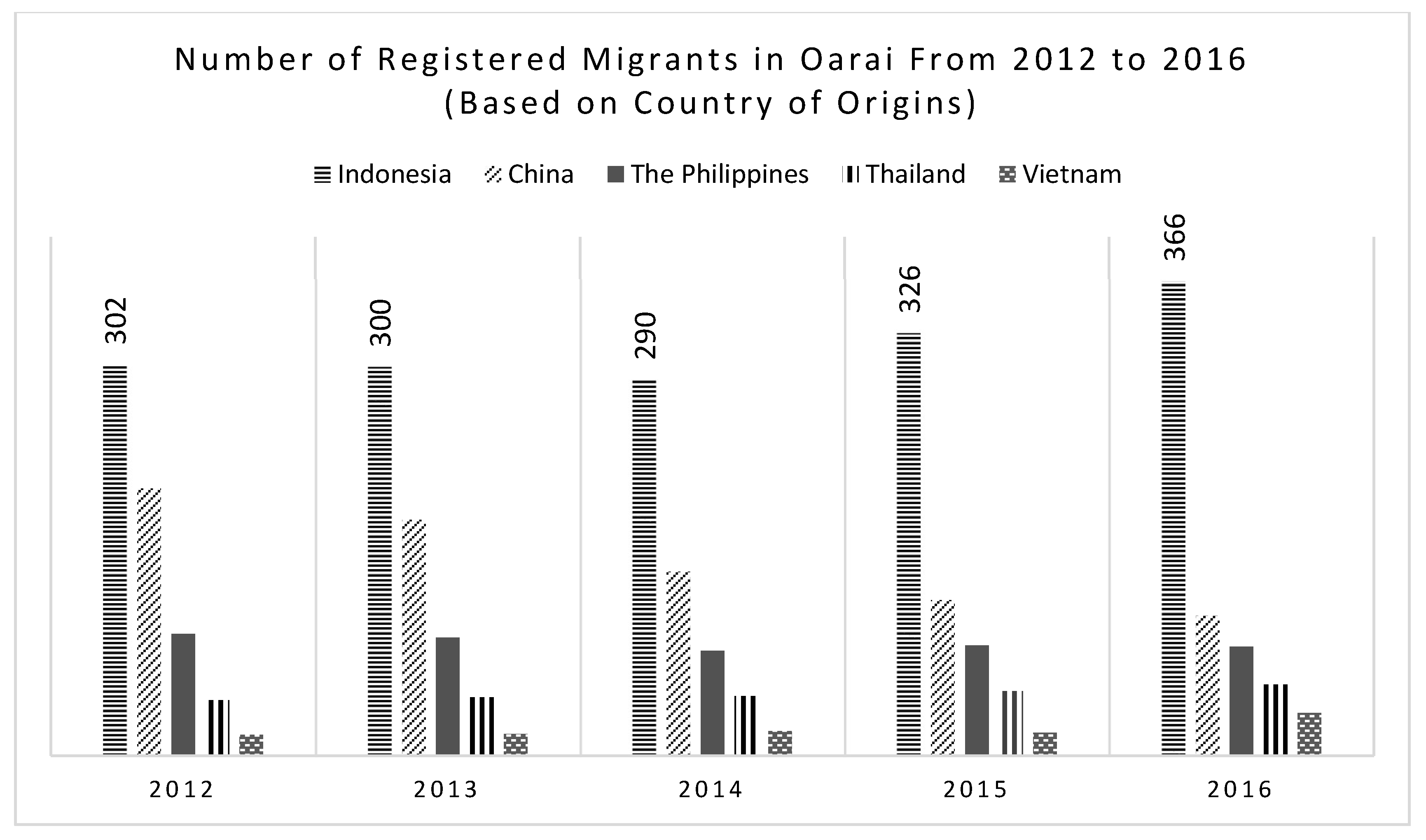
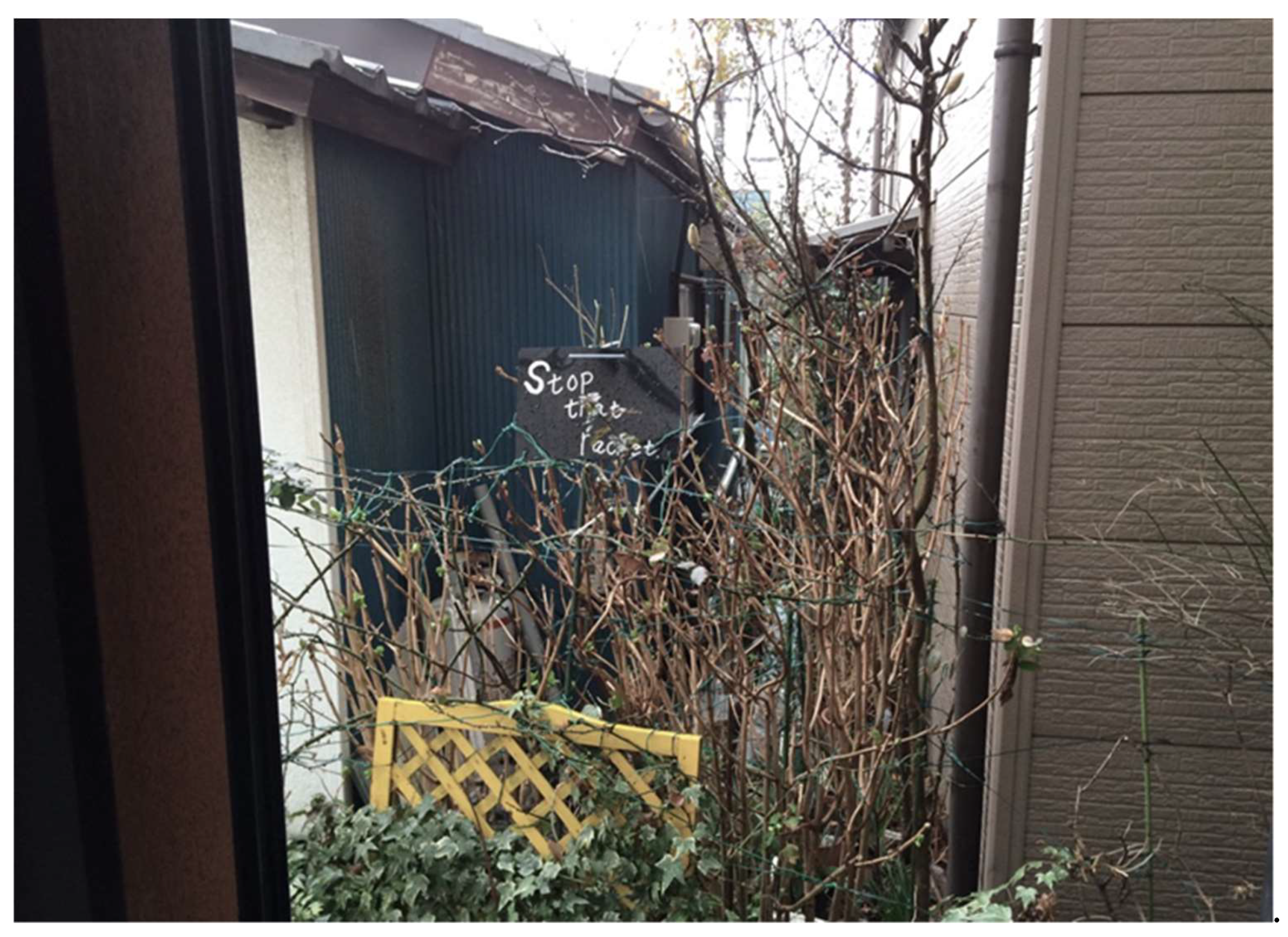
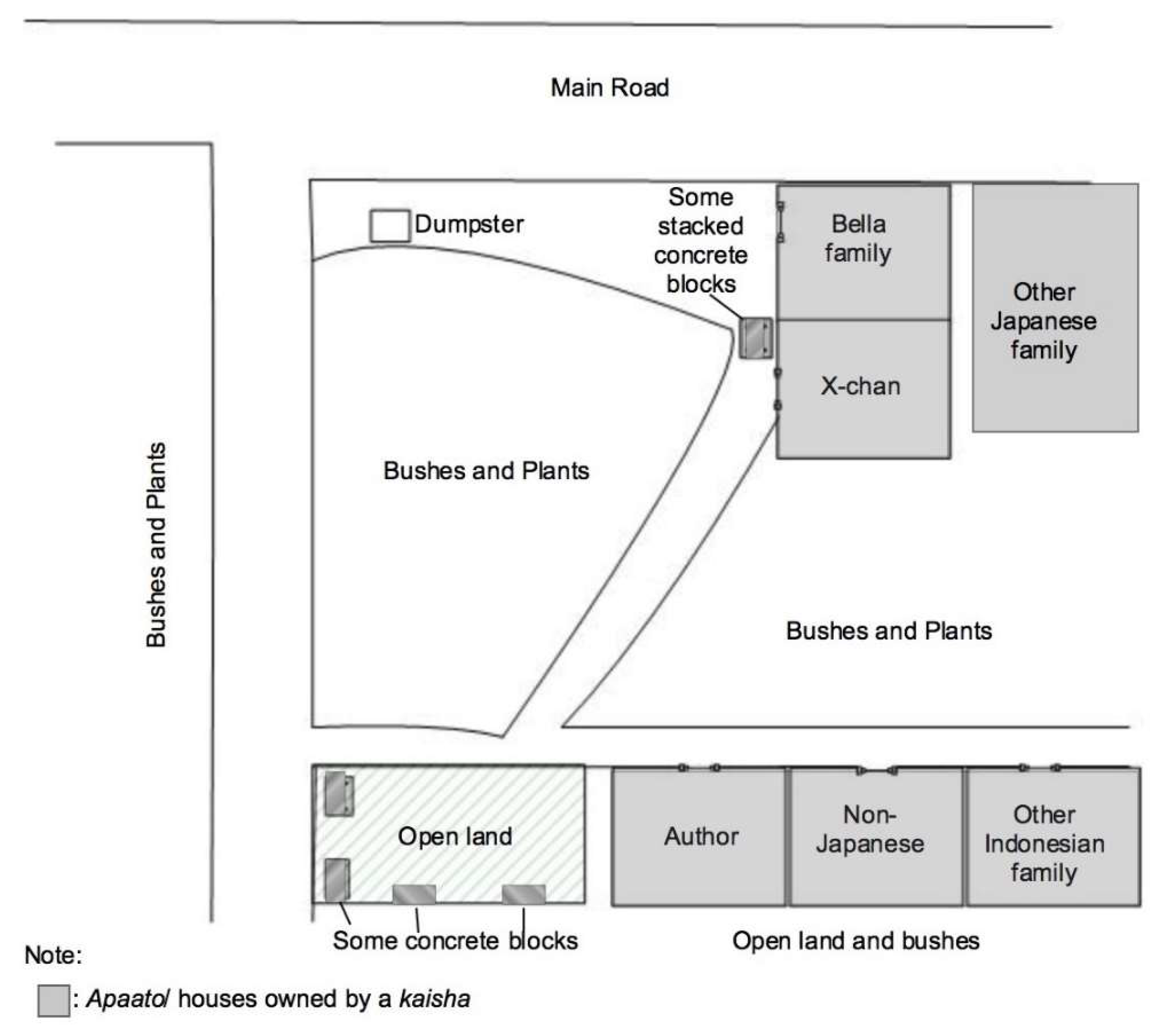

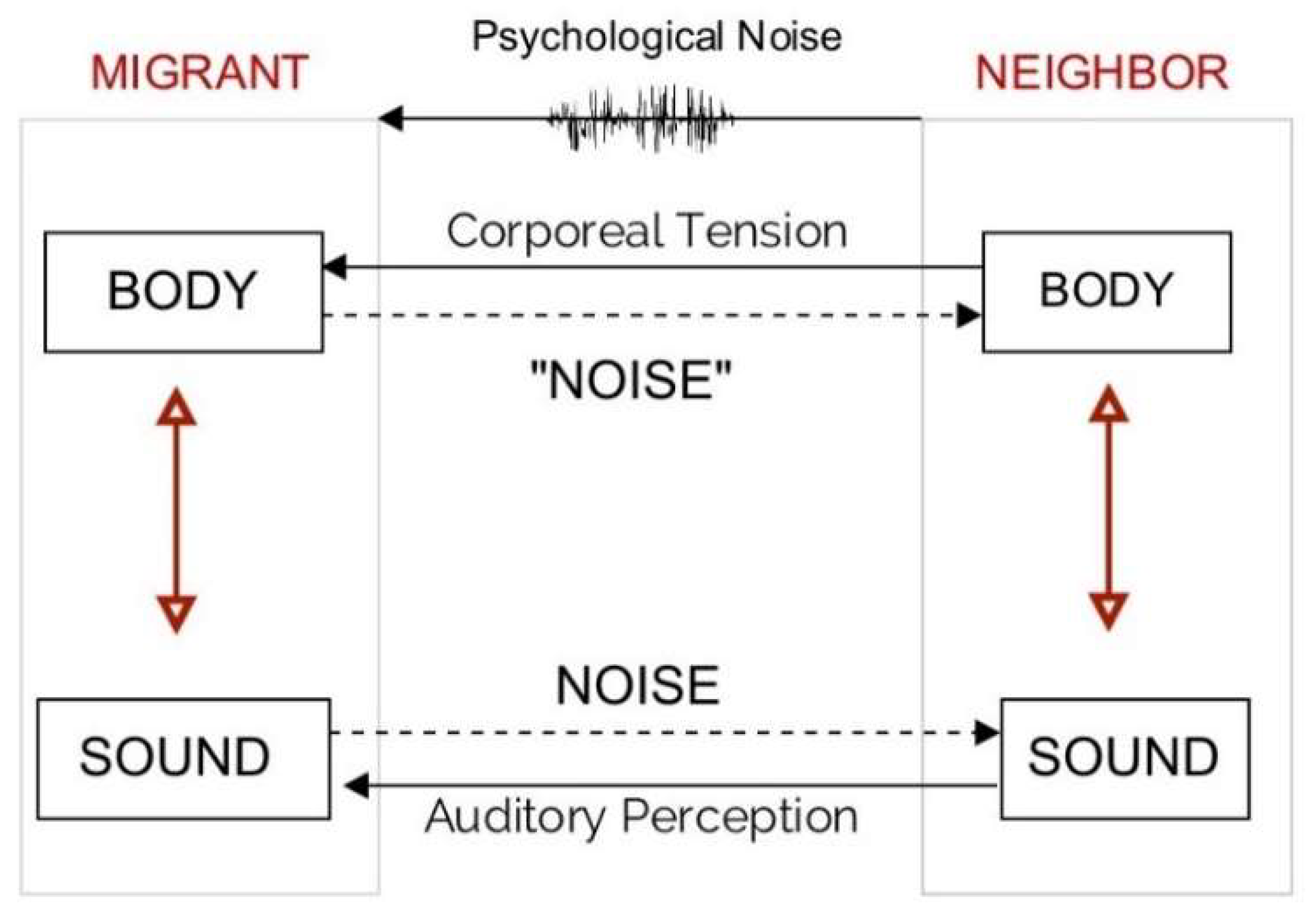
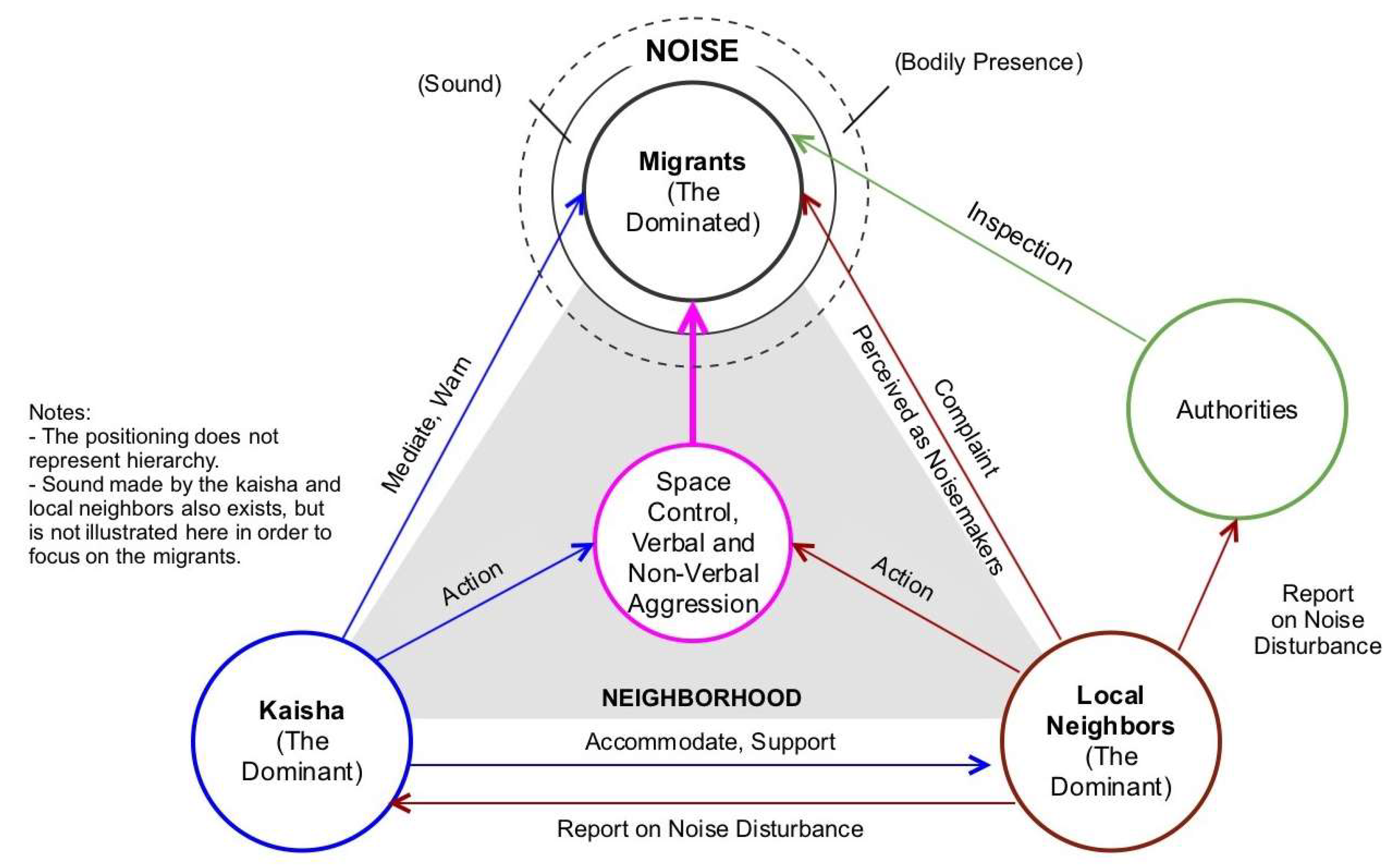
| Ownership | Housing Types | |||
|---|---|---|---|---|
| Single House | Shared House | Apaato | Mansion | |
| Company Relation | 7 | 4 | 12 | 0 |
| No Company Relation | 2 | 0 | 2 | 2 |
| Self | 1 | 0 | 0 | 0 |
| Municipal | 0 | 0 | 0 | 2 |
| Name (Pseudonym) | Sex | Age | Last Education | Japanese Generation | First Arrival | Current Work | Japanese Fluency | Type of Housing | Owner of the House/Apaato |
|---|---|---|---|---|---|---|---|---|---|
| Priscilla | F | 50s | High school | The 3rd | 1998 | worker of Kaisha A | - Speaks work-related/simple conversational Japanese | Shared House | Kaisha A |
| Leo | M | 40s | High school | Spouse of the 3rd | 2000 | worker of Kaisha B | - Speaks work-related/moderate conversational Japanese - Reads simple hiragana and kanji | Apaato | Kaisha B |
| Denna | F | 30s | University | The 3rd | 2005 | worker of Kaisha C | - Speaks work-related/moderate conversational Japanese - Reads and writes hiragana | House | Kaisha C |
| Karinda | F | 40s | High school | The 3rd | 2001 | worker of Kaisha C | - Speaks work-related/moderate conversational Japanese | House | Kaisha C |
| Bella | F | 40s | University | The 3rd | 2002 | worker of Kaisha D | - Speaks work-related/moderate conversational Japanese | House | Kaisha E (where she used to work) |
© 2018 by the author. Licensee MDPI, Basel, Switzerland. This article is an open access article distributed under the terms and conditions of the Creative Commons Attribution (CC BY) license (http://creativecommons.org/licenses/by/4.0/).
Share and Cite
Mutiara, M. Noise Complaints between Japanese Neighbors and Migrants in Rural Japan: From the Perspectives of Noisemakers. Soc. Sci. 2018, 7, 268. https://doi.org/10.3390/socsci7120268
Mutiara M. Noise Complaints between Japanese Neighbors and Migrants in Rural Japan: From the Perspectives of Noisemakers. Social Sciences. 2018; 7(12):268. https://doi.org/10.3390/socsci7120268
Chicago/Turabian StyleMutiara, Median. 2018. "Noise Complaints between Japanese Neighbors and Migrants in Rural Japan: From the Perspectives of Noisemakers" Social Sciences 7, no. 12: 268. https://doi.org/10.3390/socsci7120268
APA StyleMutiara, M. (2018). Noise Complaints between Japanese Neighbors and Migrants in Rural Japan: From the Perspectives of Noisemakers. Social Sciences, 7(12), 268. https://doi.org/10.3390/socsci7120268





